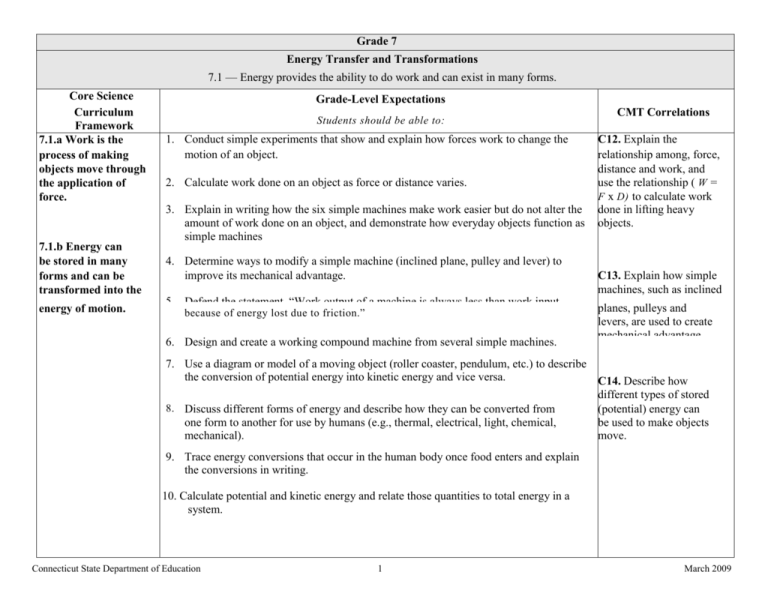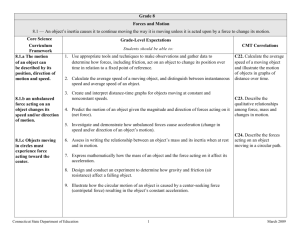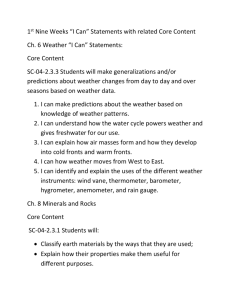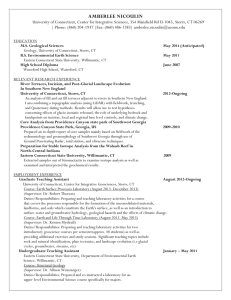Connecticut State Department of Education March 2009 Grade 7
advertisement

Grade 7 Energy Transfer and Transformations 7.1 — Energy provides the ability to do work and can exist in many forms. Core Science Curriculum Framework 7.1.a Work is the process of making objects move through the application of force. 7.1.b Energy can be stored in many forms and can be transformed into the energy of motion. Grade-Level Expectations Students should be able to: 1. Conduct simple experiments that show and explain how forces work to change the motion of an object. 2. Calculate work done on an object as force or distance varies. 3. Explain in writing how the six simple machines make work easier but do not alter the amount of work done on an object, and demonstrate how everyday objects function as simple machines 4. Determine ways to modify a simple machine (inclined plane, pulley and lever) to improve its mechanical advantage. 5. Defend the statement, “Work output of a machine is always less than work input because of energy lost due to friction.” 6. Design and create a working compound machine from several simple machines. CMT Correlations C12. Explain the relationship among, force, distance and work, and use the relationship ( W = F x D) to calculate work done in lifting heavy objects. C13. Explain how simple machines, such as inclined planes, pulleys and levers, are used to create mechanical advantage. 7. Use a diagram or model of a moving object (roller coaster, pendulum, etc.) to describe the conversion of potential energy into kinetic energy and vice versa. C14. Describe how different types of stored 8. Discuss different forms of energy and describe how they can be converted from (potential) energy can one form to another for use by humans (e.g., thermal, electrical, light, chemical, be used to make objects mechanical). move. 9. Trace energy conversions that occur in the human body once food enters and explain the conversions in writing. 10. Calculate potential and kinetic energy and relate those quantities to total energy in a system. Connecticut State Department of Education 1 March 2009 Grade 7 Structure and Function 7.2 — Many organisms, including humans, have specialized organ systems that interact with each other to maintain dynamic internal balance. Core Science Curriculum Framework 7.2.a all organisms are composed of one or more cells; each cell carries on lifesustaining functions. Grade-Level Expectations Students should be able to: 1. Compare and contrast single-celled organisms with multicellular organisms. 2. Illustrate and describe in writing the structure and the functions of the following: cell membrane, cytoplasm, mitochondria and nucleus of an animal cell. 3. Explain how the structure and function of multicellular organisms (animals) depends on the interaction of cells, tissues, organs and organ systems. 7.2.b Multicellular organisms need specialized structures and systems to perform basic life functions. CMT Correlations C15. Describe the basic structures of an animal cell, including the nucleus, cytoplasm, mitochondria and cell membrane, and how they function to support life. 4. Investigate and explain in writing the basic structure and function of the human skeletal system. C16. Describe the 5. Differentiate between the structures and range of motion associated with ball socket , and hinge joints and relate human joints to simple machines. 6. Demonstrate how the muscles, tendons, ligaments and bones interact to support the human body and allow movement. 7. Label the major parts of the human respiratory system and explain in writing the function of each part (nasal cavity, trachea, bronchi, lungs and diaphragm). structures of the human digestive, respiratory and circulatory systems and explain how they function to bring oxygen and nutrients to the cells and expel waste materials. 8. Label the major parts of the human circulatory system and explain in writing the function of each part (heart, veins, arteries and capillaries). C17. Explain how the 9. Design and conduct controlled variable experiments to analyze the interaction between human musculoskeletal system supports the body the circulatory and respiratory systems as the demand for oxygen changes. and allows movement. 10. Label the major parts of the human digestive system and explain in writing the function of each part in the chemical and physical breakdown of food (mouth, esophagus, stomach, small intestine, large intestine and rectum). Connecticut State Department of Education 2 March 2009 Grade 7 Energy in the Earth’s Systems 7.3 — Landforms are the result of the interaction of constructive and destructive forces over time. Core Science Curriculum Framework 7.3.a Volcanic activity and the folding and faulting of rock layers during the shifting of the Earth’s crust affect the formation of mountains, ridges and valleys. 7.3.b Glaciation, weathering and erosion change the Earth’s surface by moving earth materials from place to place. Grade-Level Expectations Students should be able to: 1. Illustrate and describe in writing the composition of the three major layers of the Earth’s interior. 2. Explain how Earth’s internal energy is transferred to move tectonic plates. of folding and faulting of the Earth’s crust. processes 4. Correlate common geological features/events (deep sea trenches, mountains, earthquakes, volcanoes) with the location of plate boundaries. 3. Demonstrate the 5. Compare geological features that result from constructive forces (e.g., mountains and ridges) with geological features that result from destructive forces (e.g., canyons and flood plains). 6. Analyze and interpret data about the location, frequency and intensity of earthquakes. 7. Compare and contrast the major agents of erosion and deposition of sediments: running water, moving ice, wave action, wind and mass movement due to gravity. 8. Investigate and determine how glaciers form and affect the Earth’s surface as they change over time. 9. Distinguish between weathering and erosion. CMT Correlations C18. Describe how folded and faulted rock layers provide evidence of gradual up and down motion of the Earth’s crust. C19. Explain how glaciation, weathering and erosion create and shape valleys and floodplains. C20. Explain how the boundaries of tectonic plates can be inferred from the location of earthquakes and volcanoes. 10. Observe and report on the geological events that are responsible for having shaped Connecticut’s landscape. Connecticut State Department of Education 2 March 2009 Grade 7 Science and Technology in Society 7.4 — Technology allows us to improve food production and preservation, thus improving our ability to meet the nutritional needs of growing populations. This content standard is an application of the concepts in content standard 7.2 and should be integrated into the same unit. Core Science Grade-Level Expectations Curriculum CMT Correlations Students should be able to: Framework 7.4.a Various microbes 1. Investigate and describe in writing different types of microbes and the environmental C21. Describe how conditions necessary for their survival. freezing, dehydration, compete with humans pickling and irradiation for the same sources 2. Describe the optimum conditions for rapid bacterial growth. prevent food spoilage of food. caused by microbes. 3. Illustrate and describe the structural differences between bacterial and animal cells. 4. Discover and discuss how humans use bacteria to produce food and identify examples. 5. Compare and contrast the role of bacteria in food production and food spoilage. 6. Evaluate and report how each method of food preservation including dehydration, pickling, irradiation and refrigeration works to stop or inhibit bacterial growth and give examples of each. Connecticut State Department of Education 2 March 2009









